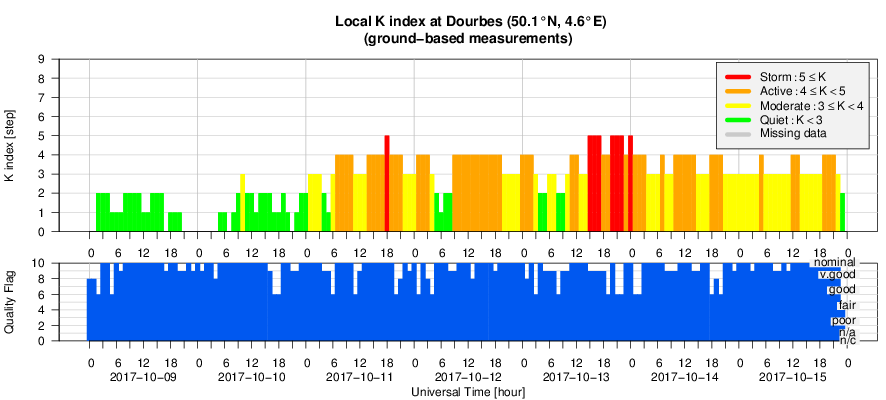- Table of Content
- 1.Something's br...
- 2.Review of sola...
- 3.The Internatio...
- 4.Geomagnetic Ob...
- 5.Weekly Space W...
- 6.Review of iono...
- 7.Future Events
2. Review of solar and geomagnetic activity (9 Oct 2017 - 15 Oct 2017)
3. The International Sunspot Number
4. Geomagnetic Observations at Dourbes (9 Oct 2017 - 15 Oct 2017)
5. Weekly Space Weather Briefing
6. Review of ionospheric activity (9 Oct 2017 - 15 Oct 2017)
7. Future Events
Something's brewing...
Space weather forecasters were alerted yesterday (18 October) by 2 strong coronal mass ejections (CMEs) originating from behind the Sun's east limb. Despite a 4 hour long gap in STEREO-A imagery (https://stereo-ssc.nascom.nasa.gov/ ), the source of the eruptions could be pinpointed to old active region NOAA 2682, which is on the Sun's farside and 2 to 3 days from rounding the east limb. The before and after imagery in extreme ultraviolet (EUV) by STEREO-A show the dramatic changes near this area, with coronal dimming and post-eruption coronal loops clearly visible.
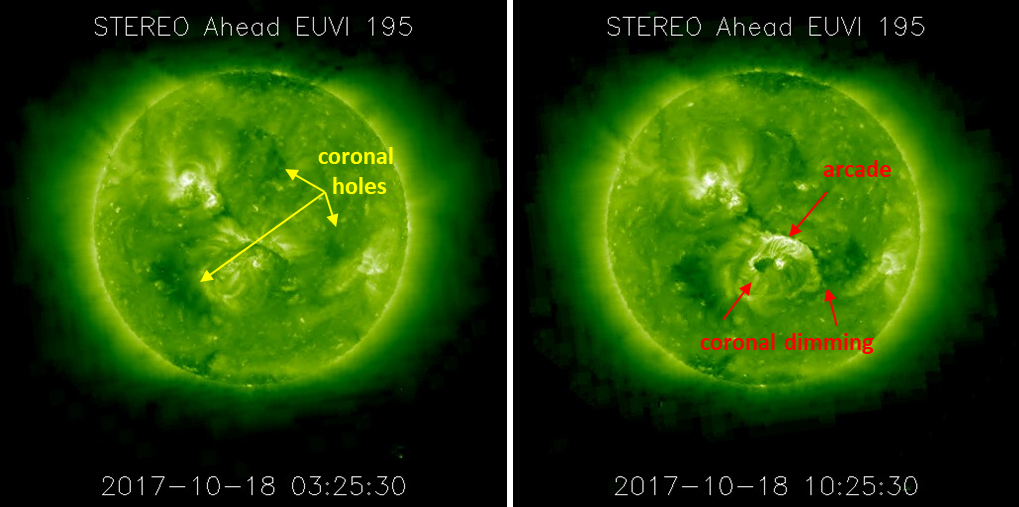
As mentioned in a previous news item (http://www.stce.be/news/406/welcome.html ), NOAA 2682 and its companion region NOAA 2683 became more active at the end of their previous transit over the earth-facing solar disk, about 2 weeks ago. CACTus analysis (http://sidc.oma.be/cactus/ ) revealed CMEs from the Sun's farside on a regular base over the next 10 days, with either one of these two regions as their source. The intensity of the 18 October eruptions was nonetheless surprizing, with STEREO-A instruments even reporting a substantial increase in the number of energetic protons. Also the planet Mercury was well connected to the proton source region, whereas the GOES proton monitors near Earth reported only nominal levels.
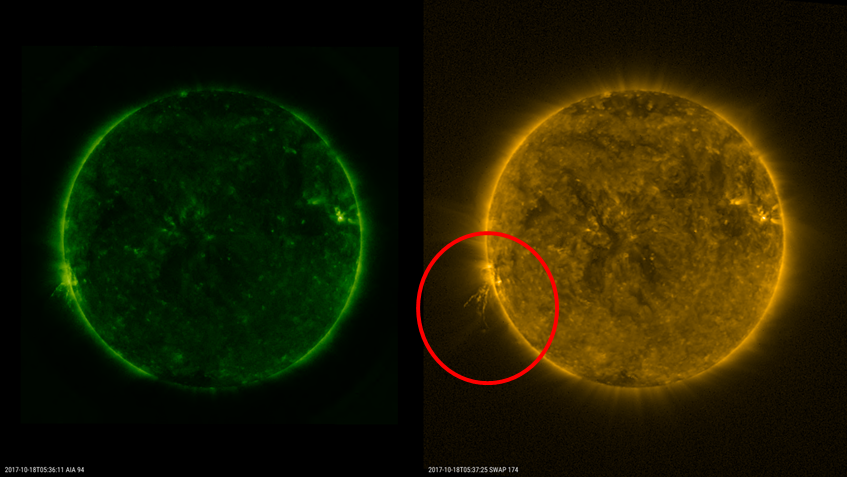
The first CME was seen in SOHO/LASCO C2 coronagraphic imagery (https://soho.nascom.nasa.gov/ ) at 05:48UT, and had a peculiar shape which was probably due to projection effects, and possibly somewhat deflected by nearby coronal holes. It was associated with radio bursts observed by various solar radio observatories around the world (daylight) during that time period, i.e. from 05:39UT till 05:45UT. SDO/AIA (https://sdo.gsfc.nasa.gov/ ) and PROBA2/SWAP (http://proba2.oma.be/ssa ) imagery revealed a violent ejection of plasma (charged particles) from behind the solar limb starting around 05:35UT. Analysis revealed a speed of about 1500 km/s. The SDO/AIA 094 and PROBA2/SWAP images above show the ejection of material at resp. temperatures of several million and 1 million degrees at 05:37UT.
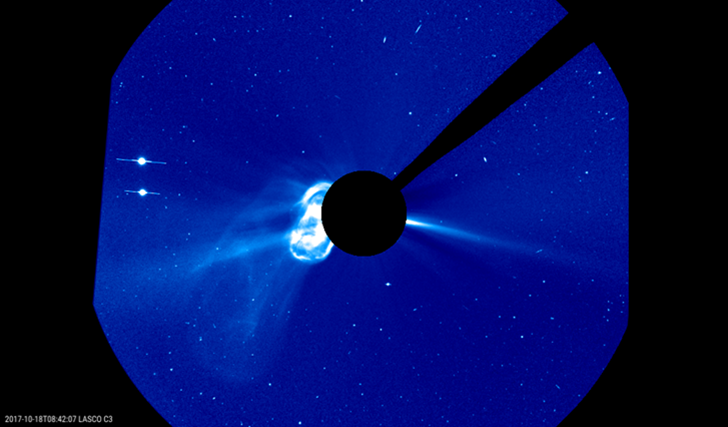
The second CME occurred in the aftermath of the first CME, and was already seen by SOHO/LASCO C2 starting around 06:50UT. Here, no radio bursts were reported by ground based observatories. SDO/AIA and PROBA2/SWAP imagery reveal a much milder ejection of plasma around this time. Analysis of SOHO and STEREO-A coronagraphic imagery gives a CME speed of about 1000 km/s. The SOHO/LASCO C3 image above shows the bright second CME following close on the heels of the already fainted first CME. None of these CMEs are earth-directed, but STEREO-A will certainly be affected (asymmetric halo CME from its point of view). The two bright dots to the left are the planets Jupiter (top) and Mercury (bottom). Both are on the other side of the Sun as seen from Earth, at distances of resp. 964 and 213 million kilometers from our planet.
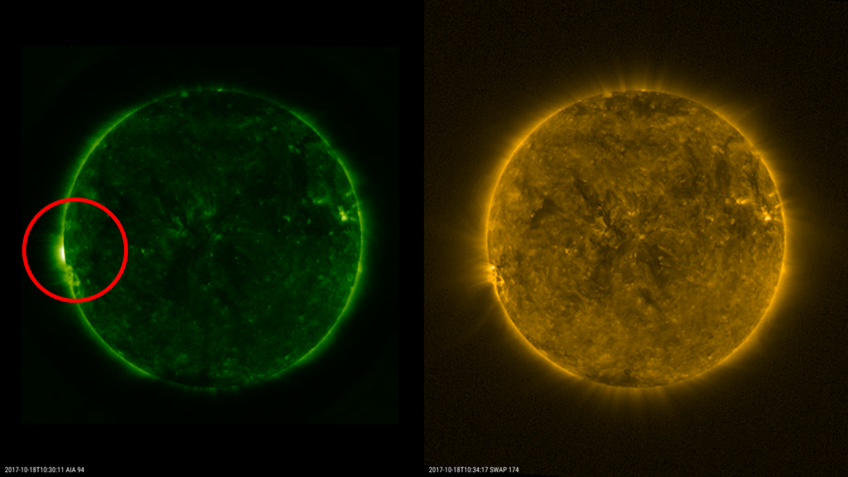
Despite NOAA 2682 being at least 2 days from rounding the east limb, the hot region on top of the developing post-eruption coronal loops towered high enough above the limb to gradually start influencing the GOES x-ray flux at Earth! A long duration event started around 08:30UT and peaked 2 hours later around 10:30UT at a modest B2.3. A brightening over the east limb can be seen in the multi-million degrees SDO/AIA 094 image above, but is absent in filters showing much cooler temperatures such as e.g. seen by PROBA2/SWAP.
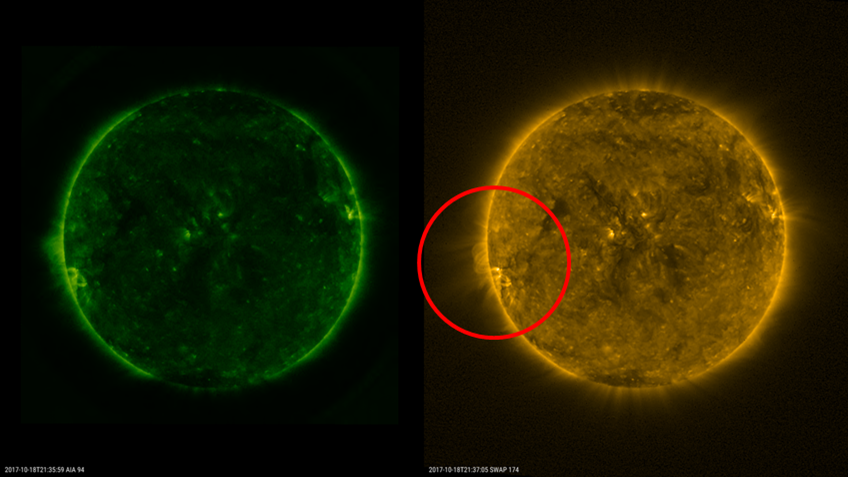
As the hot region gradually cooled down, the post-eruption coronal loops became visible from behind the limb. These loops were very well visible in PROBA2/SWAP images (see image above), as well as in SDO/AIA images with filters showing lower temperatures. They were about 70.000 km high (above the limb), corresponding to about 6 Earth diameters. STEREO-A EUV imagery shows a nice arcade, i.e. a series of post-eruption coronal loops.
Using JHelioviewer software (http://www.jhelioviewer.org/ ), a movie (at http://www.stce.be/news/408/welcome.html ; screenshot below) was created for the full day of 18 October (1 image every 6 minutes) integrating SDO/AIA 094 and PROBA2/SWAP imagery with timeline graphs from the e-Callisto network (radio bursts; http://www.e-callisto.org ) and GOES (x-ray flux; http://www.swpc.noaa.gov/products/goes-x-ray-flux ). The radio bursts are the fine yellow vertical threads around 05:45UT, the x-ray flux is the light blue curve at the bottom roughly between 09UT and 12UT.
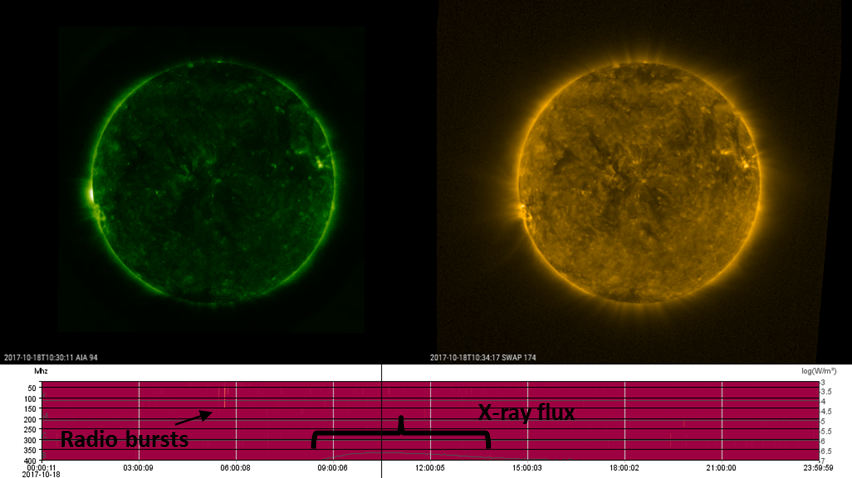
Exciting days are ahead. First of all to see the impact of the CMEs as they pass the STEREO-A spacecraft, both for the intensity as well as to see if the second CME can catch up with the first one. Indeed, although faster, the first CME has to plow through the much slower moving material of the undisturbed solar wind, allowing the second CME to run into its predecessor. The phenomenon is called "CME-cannibalism", and can lead to much stronger disturbances than if the CMEs would arrive separately. The CME pair is expected to arrive near STEREO-A late on 19 or early on 20 October. The second aspect is of course to see if NOAA 2682 and nearby NOAA 2683 will still be active when they round the east limb within a few days, and if they can increase the solar activity as seen from Earth.
Review of solar and geomagnetic activity (9 Oct 2017 - 15 Oct 2017)
SOLAR ACTIVITY
Solar activity was very low. NOAA 2683 (Catania 57) rotated over the west limb early 8 October and left the Sun spotless until almost the end of the week. Late 15 October, a new active region, NOAA 2684 popped up.
No earth-directed CMEs were observed throughout the week.
The proton flux with energies above 10 MeV remained at background level.
GEOMAGNETIC ACTIVITY
From 11 October the earth was under the influence of a high speed stream that originated from a coronal hole (CH) with positive polarity. Solar wind speed gradually increased from about 350 km/s to a speed around 700 km/s. The maximum speed was reached on 14 October. On 11 October, Bz oscillated between -9 and +9 nT with slowly decreasing amplitude of oscillations till -5 and +5 nT (on 14 October).
Geomagnetic conditions were ranging from active (Kp=4) to minor storm conditions (Kp=5) throughout the week. Except on 14 October, two 3 hours episodes of a moderate geomagnetic storm was observed (Kp=6).
The International Sunspot Number
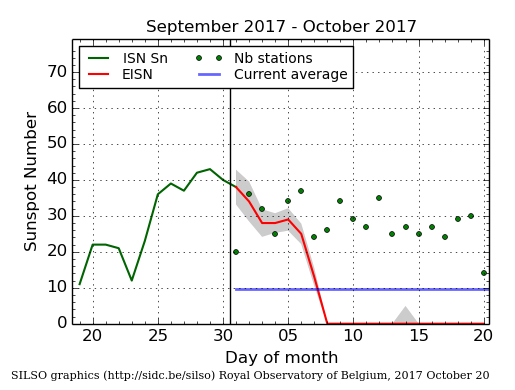
The daily Estimated International Sunspot Number (EISN, red curve with shaded error) derived by a simplified method from real-time data from the worldwide SILSO network. It extends the official Sunspot Number from the full processing of the preceding month (green line). The plot shows the last 30 days (about one solar rotation). The horizontal blue line shows the current monthly average, while the green dots give the number of stations included in the calculation of the EISN for each day.
Weekly Space Weather Briefing
The Space Weather Briefing presented by the forecaster on duty from October 9 to 15. It reflects in images and graphs what is written in the Solar and Geomagnetic Activity report.
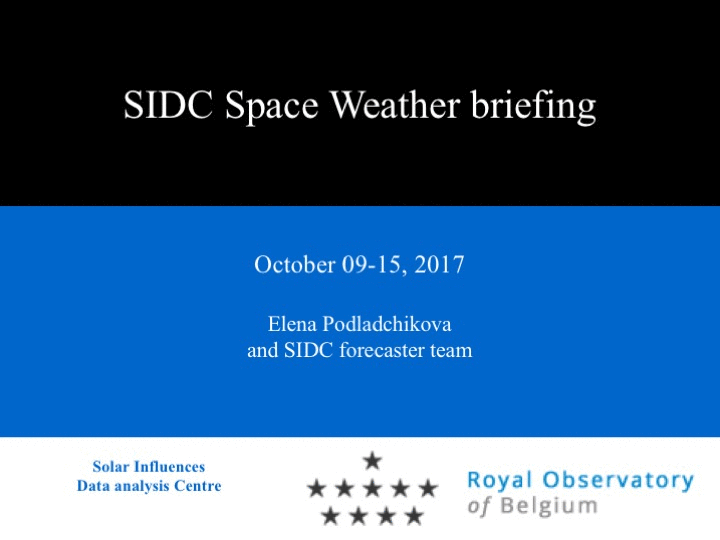
Review of ionospheric activity (9 Oct 2017 - 15 Oct 2017)
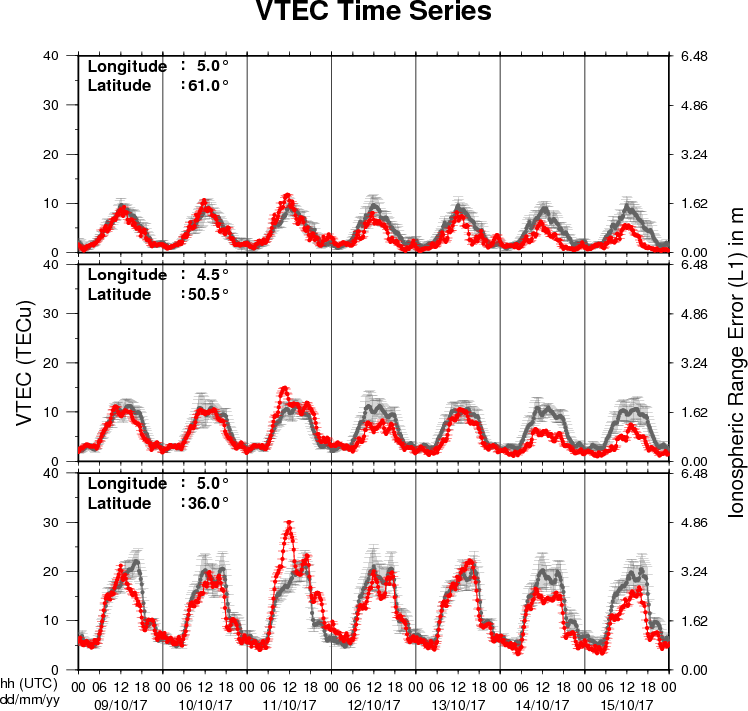
The figure shows the time evolution of the Vertical Total Electron Content (VTEC) (in red) during the last week at three locations:
a) in the northern part of Europe(N61°, 5°E)
b) above Brussels(N50.5°, 4.5°E)
c) in the southern part of Europe(N36°, 5°E)
This figure also shows (in grey) the normal ionospheric behaviour expected based on the median VTEC from the 15 previous days.
The VTEC is expressed in TECu (with TECu=10^16 electrons per square meter) and is directly related to the signal propagation delay due to the ionosphere (in figure: delay on GPS L1 frequency).
The Sun's radiation ionizes the Earth's upper atmosphere, the ionosphere, located from about 60km to 1000km above the Earth's surface.The ionization process in the ionosphere produces ions and free electrons. These electrons perturb the propagation of the GNSS (Global Navigation Satellite System) signals by inducing a so-called ionospheric delay.
See http://stce.be/newsletter/GNSS_final.pdf for some more explanations ; for detailed information, see http://gnss.be/ionosphere_tutorial.php
Future Events
For more details, see http://www.spaceweather.eu/en/event/future
International Workshop on Solar, Heliospheric & Magnetospheric Radioastronomy in Meudon, France
Start : 2017-11-06 - End : 2017-11-10
Jean-Louis Steinbeg has been one of the major pioneers in
radioastronomy. Co-founder of the Nançay Observatory, he
has actively participated to, an inspired a large number of radio
instruments on many international space missions. Jean-Louis
Steinberg is the founder of the Space Radioastronomy laboratory of
the Paris Observatory in 1963. Later on, this laboratory widened
its science interests and became the DESPA (1971) and then the
current LESIA (2002) which is one of the major space sciences
laboratories in France. The aim of this workshop is to cover the
science topics which Jean-Louis Steinberg has promoted during his
career, focusing on Solar, Heliospheric & Magnetospheric
radioastronomy & physics. This will be done by covering both
observations from either ground facilities (NDA, RH, LOFAR, Artemis
etc ...) or space missions (ISSEE, Ulysses, WIND, CLUSTER, STEREO,
CASSINI, JUNO etc ...) and models/theories. A series of invited
talks is also foreseen to cover the new developments in the
discipline which may come with the future facilities such as Solar
Orbiter, Solar Probe Plus, JUICE, JUNO, LOFAR+, SKA etc ....
This workshop will also be the opportunity to remember both the
extraordinary personal & professional lifes of Jean-Louis
Steinberg especially for new generation of scientists. At the
occasion of this workshop it is also expected that the Building 16
(historical Space Sciences building) on the Meudon campus will be
renamed "Building Jean-Louis Steinberg".
Website:
https://jlsworkshop.sciencesconf.org/
European Space Weather Week 14
Start : 2017-11-27 - End : 2017-12-01
The ESWW is the main annual event in the European Space Weather
calendar. It is the European forum for Space Weather as proven by
the high attendance to the past editions. The agenda will be
composed of plenary/parallel sessions, working meetings and
dedicated events for service end-users. The ESWW will again adopt
the central aim of bringing together the diverse groups in Europe
working on different aspects of Space Weather.
Website:
http://www.stce.be/esww14/
